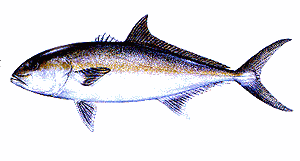Species Identification : Greater Amberjack
 Scientific Name: Seriola dumerili
Scientific Name: Seriola dumeriliThe Greater Amberjack is the largest of the jack species, as well as the most sought after. They take their name from the amber colored stripe that runs along the sides of their body. They are probably the most widely recognized jack species in the Atlantic because of their close proximity to the major population centers along the Atlantic coast of the United States. Greater amberjack are an olive-brown or green-blue color above the lateral line, though they can sometimes appear purple. Below the lateral line coloration is silver-white. A dark olive-brown stripe runs diagonally from the mouth to the first dorsal fin. These stripes are often referred to as “fighter stripes” and tend to become brighter when they are excited, such as when feeding or fighting. A wide stripe, amber in color, runs horizontally the length of the body, though it disappears upon death. The fins have a dusky hue or a yellow tint; this is especially true for the dorsal fins. Greater amberjack have a slender, elongated oval form that culminates in a v-shaped tail fin, which enables fast swimming. The head is short and pointed and the mouth possesses small teeth aligned in bands with 12 to 15 gill rakers. The eyes are relatively small. The first dorsal fin is relatively short and has six or seven spines linked by a membrane. The second dorsal fin is composed of one spine and 29 to 35 soft rays. The spines on each of the dorsal fins are sharp and somewhat fragile. The anal fin consists of three spines and 19 to 22 soft rays. The first two of these spines are detached and may have a skin-like covering. Greater amberjack are sometimes confused with bluefish and yellowtail. However, the amberjack tail is more concave than that of the bluefish, and they have fewer gill rakers than the yellowtail.





<< Home